Natural Solutions to Things That Bug You (33 page)
Read Natural Solutions to Things That Bug You Online
Authors: Myles Bader

CORN EARWORM
Identification:
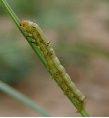 This worm is about 2 inches long and may be found in shades of green, brown or yellow. Its sides will be darker than the bodies. The adults are light brown or gray moths with black spots and about a 1½-inch wingspan.
This worm is about 2 inches long and may be found in shades of green, brown or yellow. Its sides will be darker than the bodies. The adults are light brown or gray moths with black spots and about a 1½-inch wingspan.
General Information:
These worms are also known as tomato fruitworms or cotton bollworms. Their garden food consists of corn, tomatoes, cotton, peppers, eggplant, okra, potatoes, squash, beans and peas. They will attack the tender shoots as soon as they break the surface. They love to chew on the corn silk and disrupt the germination process. They chew holes in green tomatoes and may move on and not even finish their meal. If you have flower buds that have become damaged it would be best to remove them.
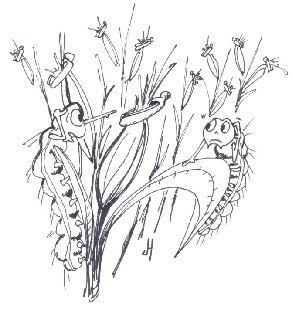
CLOTHESPINS TO THE RESCUE
If you clip a clothespin to the tip of each ear of corn to keep the husk tight you will not have a worm problem. You will, however, have the funniest-looking cornfield in your vicinity.
PLANT RESISTANT VARIETIES
There are a number of varieties that can be planted that the worms will not bother with. These include ones with tight husks such as Try Country Gentleman or Silver Cross Bantam corn.
PLANT REPELLANTS
There a few plants will repel these worms very efficiently. These need to be planted within the rows and include smartweed or sunflowers.
BIOLOGICAL CONTROL
Bt sprayed on the plants works great. Tachinid flies and wasp parasites will also do the trick. The commercially available virus Elcar™ can also be used as well as NPV very effectively.
SCREEN THEM IN
If you have a number of valuable plants the best thing to do is to screen them in with a piece of cheesecloth or other porous material.

CUTWORM
Identification:
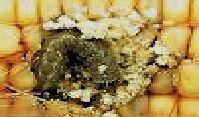 There are many species of cutworms and their color varies from green to white, brown and even black. They may also have stripes or be banded. They are plump, soft-bodied larvae covered with coarse hair.
There are many species of cutworms and their color varies from green to white, brown and even black. They may also have stripes or be banded. They are plump, soft-bodied larvae covered with coarse hair.
General Information:
They seem to like vegetables the best and head for corn, beans and cabbage first if they are available. They will eat almost anything. One of their favorite foods, are tender seedlings. They don’t eat a lot but can cause a lot of damage by cutting off the plants by the stems and killing them. Some cutworms will climb up the plant and eat the leaves. They will be on the soil surface at night, which leaves them vulnerable.
ATTACK THE EGGS FOR CONTROL
Use trichogramma and lacewings to attack and eat the eggs. They love cutworm egg omelets. Applying Nc nematodes around plants will also solve the problem.
FOILED AGAIN
You can wrap aluminum foil around the stems of plants that you may be worried about to stop cutworms from eating the stems. Rub a little garlic juice on the foil to make it more effective.
COLLARS FOR THE BUGS
If you are having a problem with cutworms, try placing small cardboard collars around the stem of the plant and place it just under the ground at least 1-2 inches. You can use old toilet paper or paper towel tubes. Just cut them; place them on and then staple them closed. You can also use tarpaper rolled up and aluminum foil will also do the trick wrapped around the stem.
LEAVES AS WRAPS
Hundreds of years ago cutworm infestations; were solved by placing hickory or walnut leaves around the stems of the plants. Cutworms shy away from these leaves.
SANDPAPER TO THE RESCUE
If you place a collar of sandpaper or roofing shingle around the base of the plant as a collar it will stop the cutworms from doing their thing.
AH CHOO
Cutworms can be eliminated with black pepper spray. Just crush up 1 tablespoon of the seeds into a powder, add water and spray any stored grains where you have a problem. The powder can also be used and spread around the affected area.
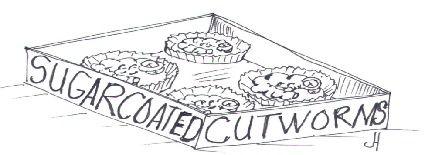
MUMMIFY THEM
Prepare a mixture composed of molasses, hardwood sawdust and wheat bran.
If the cutworm even crawls into this mixture it will dry them up and make sweet little wooden mummies out of them.
GRAIN KILLS CUTWORMS
Soak 2 handfuls of finger millet (grain with grass-like leaves) in 1 quart of water, strain and spray.
CRUSH THOSE SEEDS
The castor oil plant can be used to eliminate cutworms by placing 4 cups of the crushed, shelled seeds into 2 quarts of water and boiling for about 10 minutes, then adding 2 teaspoons of paraffin and ½ teaspoon of liquid soap to the mixture. Add 7 more quarts of water to dilute and spray into the soil in the affected areas.
Castor bean seeds are poisonous to some animals and humans.
THEY HATE TO COMMUTE
You can go out at night and find this pest with a flashlight and look for them chomping on the plant leaves. In the daylight they tend to rest just next to the base of the plant so that they will not have far to go for their next meal.
PAWPAW SEEDS WORK
Crush 1 cup of pawpaw seeds and place them in 2 cups of water and allow it to stand for 24 hours. Strain and spray the areas. Test a leaf or two to be sure that there will be no plant damage. If there is damage add more water and dilute the spray.
LE PEW
Garlic spray for cutworms:
3 Cups of warm tap water
3 Tablespoons of mineral oil
3 Whole garlic bulbs
1 Tablespoon of Ivory Liquid Soap™
First separate the cloves of garlic and chop in a food processor. Place the cloves in a jar with the mineral oil and allow it to stand for 24 hours before adding the water and soap. It is best to store the mixture in the refrigerator with a tight cover. To use as a spray dilute ½ cup in 1 quart of water. Spray directly on the plants for an instant kill.
OUCH THAT HURTS MY FEET
If you sprinkle oak leaf mulch or use crushed eggshells around the plants it will stop the cutworms from attacking the plants. The sharp edges hurt their tender footsies. You can also sprinkle DE or wood ashes around to irritate them.
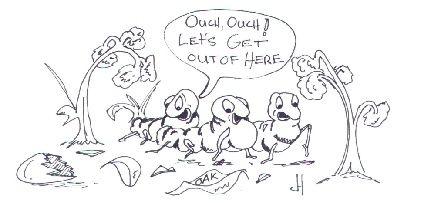
BLOATING UP A CATERPILLAR
 If you want to kill them just sprinkle some cornmeal around the plants and they will eat it, bloat up and die.
If you want to kill them just sprinkle some cornmeal around the plants and they will eat it, bloat up and die.
